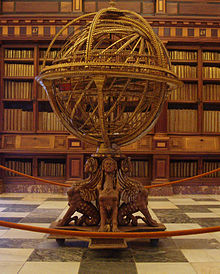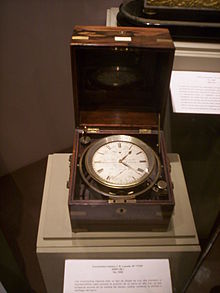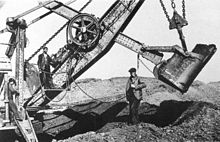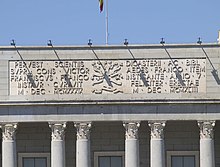History of science and technology in Spain
The presence of science and technology in Spain dates back to Spain's prehistoric period. It is taken to include firstly an account of the historical development of these fields of study, and secondly a description of the current institutional and regulatory framework for continuing this development into the future.
History
The scope of Spain's history with science and technology generally overlaps with the
¡Que inventen ellos! (Let them invent!)
— Miguel de Unamuno, various versions, 1906–1912
Prehistory
Given the absence of written sources, the reconstruction of aspects of pre-scientific and pre-technological thought has been attempted through analysis and interpretation of paleolithic art – of which the Iberian peninsula possesses examples of exceptional value; through studies of stone-working techniques; and through anatomical reconstructions.
The pre-neanderthal (
The theory of the "
During the first civilisations in the Middle East, the part played by the "Far Western" regions in long-distance metal trading was vital for the development there of Bronze Age metallurgical techniques. Next, around 1000BC, Iron Age metallurgy was introduced simultaneously but independently to Iberia by Mediterranean colonisers (Greek and Phoenician) on the southern and eastern coasts, and by Celts from Central Europe in the centre, west and north. Less is known of the introduction of other technologies such as the wheel, the plough and the sail.
The Roman Period
Romanisation proliferated throughout Hispania, as shown in the construction techniques that gave rise to such completed structures as the Alcántara bridge or the Aqueduct of Segovia; a complex network of roads; the first dams for water storage (although whether these are in fact Roman is still under debate);[9] or different types of mining ranging from large-scale gold mines such as that at las Médulas to the extraction of lapis specularis.
Some of the most important scientists of the
Among the few still surviving Hispano-Latin names that wrote scientific topics at that time are
And I can never cease to wonder, when I consider how those who wish to speak well choose an orator whose eloquence they imitate; those who wish to learn the rules of calculation and measurement seek a master of this learning who pleases them so much; those who love music and dance take great care to find masters of these arts; those who want to construct a building call upon tradesmen and architects; those who wish to sail the sea seek men who know how to manage a boat; those who engage in war seek skilled tacticians; in short, everyone taking pains to find the best guide they can for that field of study to which they want to apply themselves...: only agriculture, which is certainly very close to wisdom, and has some sort of kinship with her, lacks pupils to learn it and masters to teach it.
— Lucio Junio Moderato Columela, Twelve books on agriculture, On rural matters (De re rustica), mid-1st century AD.[11]
Medieval science
It was in the Iberian peninsula that
The transition from feudalism to capitalism implied technological changes driven forward or hindered by the different socio-economic structures, which in Spain were made manifest in the different forms of innovation in agriculture, livestock farming, food production and other crafts. In some cases these were promoted by institutions – monasteries or craft guilds; in other cases they arose from within the productive activities themselves, which to a greater or less extent kept their "trade secrets" and in the stratified society of the time were deprecated as "vile and mechanical trades".[12][13] The most spectacular examples of the technology of this period are the water wheels of South-eastern Spain, together with other irrigation techniques introduced or perfected by the Arab-Hispanic civilisation.
The incorporation of the later medieval kingdoms of Spain into European
Early modern science


The effects of the
These trade practices were linked to the Jewish and
The economic importance of the Spanish treasure fleet and the exploitation of minerals from the New World called for science and technology of the highest level, above all in the maritime and metallurgical fields. The clear priority for any conceivable "scientific programme" would have been to address the needs of the immense overseas empire.
A notable example of Spanish scientific aspirations at the time was in 1598, when
While the
How pitiful and indeed shameful it is that, as if we were Indians, we should have to be the last to receive news and insights already spread throughout the rest of Europe. And likewise, that men who come to realise this take offence at the warning and fester in disappointment. And how certain it is that trying to diverge from the decree of an outdated opinion is among the hardest things that men attempt!
— Juan de Cabriada, "Philosophical-medical-chemical letter", 1687.[18]
The Enlightenment
Throughout the Age of Enlightenment, the awareness of the poor state of science and technology in Spain arose out of the "negative introspection" of the arbitristas of the 17th and especially the 18th century. In the "light of reason" these sought progress in applied science. Following the debate generated by Masson de Morvilliers' provocative question "What do we owe to Spain?" it became a commonplace that unlike literature and the arts, science in Spain considerably lagged behind that in other European countries. Indeed, this became such a prevalent cliché as to provoke a "complaint about the complaint" among writers such as Cadalso or Larra (Cartas marruecas, En este país).
In reality the field of "science" was not clearly distinguished from that of "letters" or "
"Letters" at this period embraced
Regardless of the adverse circumstances prevailing in the late 18th and early 19th centuries (
Resistance to modernisation in Spain was expressed in the strong antagonism between the
19th century
The
At any rate, the gathering together of funds scattered during the sackings allowed the opening of the Prado Museum in Madrid, in the building originally intended as the base for the Royal Office for Science, the National Library, and other academic institutions. Gradually, the university sector was renewed: one major act was the move of the former University of Alcalá to Madrid as the Universidad Central. Primary and secondary education were developed as the foundation of a far-reaching educational programme (es:Ley Moyano), which however was not implemented effectively or widely until the Second Republic of 1931–36.[30]

The economy of the 19th-century
Awareness of having fallen behind was growing all the time, especially in the liberal élites, among whom were spreading strongly expressed slogans deriving from the Black Legend of the Spanish Inquisition.
If, overlooking those centuries during which the Arab civilisation made Spain the first country in the world as regards science, we focus only on the modern era, from the fifteenth century onward, you will well understand that this is not, and cannot be, the history of science in Spain, because a people without science can hardly have a scientific history. The flawed account you have heard is an historical summary of mathematical science, yes, but in Italy, France, England, Holland, Germany, Switzerland...; it is not the history of science here, where there was only the whip, iron, blood, prayers, braziers and smoke.
—José de Echegaray (1866), Speech on admission to the Spanish Royal Academy of Sciences[18]
Such views were condemned in their turn as anti-Spanish propaganda, drawing on the studies of Julián Juderías. His 1914 work "The 'black legend' and historical truth"[32] claimed that a wide range of Spanish scientists had been active during the Spanish Golden Age. His list can be found in a footnote to the Spanish Wikipedia article.
The "polemic of Spanish science", in which the reactionary thought of Menéndez and others was opposed by the "krausista" followers of the German philosopher Krause, developed following the restoration of the Bourbon monarchy in 1875. Later, as reaction to the disaster of the Spanish–American War of 1898, a "regenerationist" movement arose.
20th century
The award of the Nobel Prize for Medicine in 1906 to the Spanish scientist Santiago Ramón y Cajal, at a time when Spanish science had in general little to be proud of, ushered in what became known as a "Silver Age" of Spanish letters and sciences during the first third of the twentieth century.
At present, when scientific research has become a recognised profession with State funding ... those former times have passed when anyone curious about Nature, shut in the silence of his study, could be sure that no rival would disturb his quiet musings. Nowadays, research is a fever: hardly is a new technique outlined, when many other scholars take it up and apply it almost simultaneously to the same problems, tarnishing the glory of the original inventor. ... In Spain, where laziness is not just a vice but a religion, people find it hard to grasp those monumental works of the German chemists, physicists and doctors, in which it would appear that just making the diagrams and searching the literature must take decades, and yet those books have been written within one or two years. ... The whole secret lies in the method of study ... in short, in not incurring the mental expense of that witty chat of the café and the social gathering, which takes away our nervous energy and with new and futile concerns distracts us from the main task.
— Santiago Ramón y Cajal (1897), Speech on admission to the Spanish Royal Academy of Sciences[18]
The Spanish Civil War was another tragedy for Spanish science, bringing about the exile of a whole generation of scientists – the next Spaniard to win the Nobel Prize for medicine, Severo Ochoa in 1959,[33] had taken American citizenship – and the moribund intellectual life in "internal exile" of many other scientists during the long poverty-stricken postwar period depicted in Luis Martín-Santos' novel Time of Silence (Tiempo de silencio). It was indicative of the National Catholicism of the time that one of the biggest scholarly projects was the Library of Christian Authors (1944). However, despite censorship, over time the publishing trade diversified and showed a great capacity for innovation, both technically and of content.

The policy of
We aim at a Catholic science. At this moment we therefore eliminate all the scientific heresies that dried up the channels of our national genius and sank us into lethargy and decay. ... Our present-day science, in common with that which defined us in past centuries as a nation and an empire, seeks to be above all Catholic
— José Ibáñez Martín, inaugural speech as President of the CSIC, October 1940.[34]
Individual or collective achievements such as the
The development drive that got under way in the 1960s speeded up as regards scientific and technical achievement during the final quarter of the century, with the Spanish transition to democracy and the entry into the European Union. Spain was ranked 30th in the Global Innovation Index in 2020 and 2021, down from 29th in 2019.[37][38][39][40][41]
Regulatory framework
Although faces a limited situation due to the deep budget cuts entailed by the
Since the second decade of the 21st century, the departure of many private companies abroad, forced by the 2008-2013 crisis, has resulted in the need to compete and survive in the global market, especially in emerging markets, generating greater scientific application and technology, and consequently greater private investment in research.
See also
References
- ISBN 84-206-5626-7. (Descarta la Edad Media (cristiana y musulmana), para iniciar el libro en el Renacimiento y la España imperial, con su auge y posterior decadencia en el Barroco). Manuel Desantes ¿Cómo que inventen ellos?. Conferencia: Un repaso de los últimos quinientos años de la historia de la ciencia y la tecnología en España explica el retraso estructural actual. El II Congreso de la sociedad española de historia de las ciencias (Jaca, 27 de septiembre–1 de octubre, 1982) fue dedicado a La ciencia y la técnica en España entre 1850 y 1936, teniendo entre otras, ponencias con estos títulos: Antonio Ferraz Perspectivas institucionales de la historia de la ciencia y de la técnica en España; Eduardo Ortiz Sobre la ciencia y la técnica en España en el siglo XIX; José Luis Peset La historia de la ciencia y de la técnica en el curriculum profesional del científico y del ingeniero.
- ^ Thomas F. Glick, Eugenio Portela Marco, Víctor Navarro Brotóns: La historia de la ciencia en España como realidad marginal en su organización y contexto social, Anthropos, 1982, Número 20, especial dedicado a José María López Piñero. ficha en dialnet
- ISBN 978-968-403-041-1, pp. 80–81
- ^ Henri Frankfort, Wilson and Jacobsen: The Intellectual Adventure of Ancient Man, 1946, later titled Before Philosophy, translated into Spanish as El Pensamiento Prefilosófico, FCE
- ^ Ignacio Martínez, Human Evolution conference, CTIF, Alcalá de Henares 29 April 2009
- ^ Juan Luis Arsuaga, El collar del neandertal (En: The Neanderthal’s Necklace), El enigma de la esfinge (En: The Riddle of the Sphinx) and other works.
- ISSN 0007-9502, especially p. 52 et seq.
- ^ El calcolítico en la Península Ibérica (España) (The Chalcolithic period in Iberia) in Artehistoria.
- ^ Mérida. Una investigación de cinco años sobre la presa de Proserpina descarta su origen romano Archived 2008-05-16 at the Wayback Machine: Terrae Antiquae, 26 de abril de 2006 (quotes a range of sources)
- ISBN 8400052439, p. 49.
- ^ First book: Prologue to Publio Silvino, pp. 1–2. Translated by Juan María Álvarez de Sotomayor y Rubio, 1824 edition (printed by Miguel de Burgos) digitalised in Google Books
- ^ Díez, Fernando (1990) Viles y mecánicos. Trabajo y sociedad en la Valencia preindustrial (Vile and mechanical: work and society in pre-industrial Valencia). Valencia, Edicions Alfons el Maganànim.
- ^ Mª Rosario Caballero Carrillo y Pedro Miralles Martínez (2002) El trabajo de la infancia y la juventud en la época del Barroco. El caso de la seda murciana (Child and youth labour in the Baroque period: the example of the silk industry in Murcia)
- ^ Fundación Museo de las Ferias. Documents from the fairs of Medina del Campo, Villalón and Medina de Rioseco, 2002
- ^ Daniel Mediavilla, El GPS de las estrellas (The GPS of the stars), Publico.es, 19 August 2008 Archived 13 July 2010 at the Wayback Machine
- ^ Catalogue of the Spanish Museo Nacional de Ciencias Naturales, p. 68.
- ^ Roberto Moreno José Rodríguez de Losada. Vida y obra (Life and Work). Archived 2013-12-02 at the Wayback Machine 1995, Madrid: Fundación Juanelo Turriano.
- ^ ISBN 84-294-4976-0, p. 89
- ^ Miguel de Cervantes, Don Quixote, ch.38, The Literature Network
- ISBN 84-95215-57-8, pp. 31–55.
- ^ Filosofía e historia natural en la Ilustración (Philosophy and natural history in the Enlightenment), University of Valladolid Archived 2010-04-04 at the Wayback Machine
- Inca Garcilaso), in Ensayos de cultura virreinal latinoamericana (Essays on Latin American culture under the viceroys), Lima: University of San Marcos.
- ^ Francesc Gómez Morales (2006), Cómo los jesuitas inundaron Europa de científicos (How the Jesuits flooded Europe with scientists). Forum Libertas
- ^ Vicente Faubell Zapata (2008), Historia de la acción educativa de los Escolapios en España de 1733 a 1845 (History of educational activities of the Piarists in Spain, 1733-1845), Universia
- ^ Malaria. Exhibition in the National Library, 2009. La Condesa, los Jesuitas, el Cardenal, el Demonio, Linneo y sus Polvos (The Countess, the Jesuits, the Cardinal, the Devil, Linnaeus and his Powders) Archived 2007-06-22 at the Wayback Machine
- ISBN 978-84-8432-916-9.
- ISBN 978-84-321-2441-9. [1]
- ^ Mariano José de Larra (1836), De 1830 à 1836, ó, La España desde Fernando VII hasta Mendizabal: resumen histórico critico, p.13. Imprenta Repullés
- ISBN 978-84-7039-225-2.
- ^ Museo Pedagógico de Huesca website: standing exhibition on education.
- ^ Ángel Bahamonde, Política económica y liberalización, in Artehistoria.
- ^ Julián Juderías (1914), La leyenda negra y la verdad histórica: contribución al estudio del concepto de España en Europa, de las causas de este concepto y de la tolerancia política y religiosa en los países civilizados. Madrid, Tip. de la Revista de Archivos.
- ^ Official webpage of the Nobel Prize committee, stating that "Titles, data and places given above refer to the time of the award".
- ^ Quoted by Carlos Elías, in "Los científicos piden que el CSIC no tenga carácter político. Denuncian el espíritu anticientífico que rige este organismo en su 60 aniversario (Scientists call for CSIC to be non-political, condemn the anti-scientific spirit prevailing in that body on its 60th anniversary)", El Mundo, 15 October 2000.
- ^ La erradicación del paludismo en España Catalogue of the exhibition "Malaria", National Library of Spain, May 2009. The official declaration coincided with the 25th anniversary of the end of the Civil War
- ^ La Gaceta, Report of the 40th anniversary of the 1968 heart transplant, 17 September 2008
- ^ "Global Innovation Index 2021". World Intellectual Property Organization. United Nations. Retrieved 2022-03-05.
- ^ "Release of the Global Innovation Index 2020: Who Will Finance Innovation?". www.wipo.int. Retrieved 2021-09-02.
- ^ "Global Innovation Index 2019". www.wipo.int. Retrieved 2021-09-02.
- ^ "RTD - Item". ec.europa.eu. Retrieved 2021-09-02.
- ^ "Global Innovation Index". INSEAD Knowledge. 2013-10-28. Retrieved 2021-09-02.
- ^ The CSIC has lost 10% of its workforce in a year and a half. Until 2010 staff numbers had been rising in spite of budgetary cutbacks., El País, 1/08/2013
- ^ es:Mikel Buesa, El sistema nacional de innovación en España: Un panorama, en Innovación y Competitividad, noviembre-diciembre 2012 ....investigates the recent evolution of support for innovation in Spain in the light of strategic aspects of resource allocation for this purpose during the period from 2000-2010. The author reviews scientific research activities with reference to cost-benefit and results. Technological activity by innovative businesses is analysed on the same basis, and is shown to be insufficiently productive to meet the country's needs. The paper also addresses the role played by policies for science and technology. Its conclusions show that, despite moving closer to the model characteristic of EU countries in general, Spain continues to demonstrate a significant weakness in the area of innovative businesses.
- ^ 16/11/2010.- El INE presenta la Estadística sobre Actividades de I+D en 2009. Análisis del I+D en España en 2010: desequilibrio empresarial en la inversión que hay que corregir. Informe COTEC 2012, I+D+i en España: falla la inversión, no el rendimiento, in eldiario.es, 19/06/2013: In the past decade, the Spanish R&D sector has doubled scientific output in quantity, quality and the extent of technology transfer. When the figures for scientific and technological production are adjusted to reflect levels of investment in R&D, the performance of Spain's science and technology sector compares favourably with those of Germany, France and the USA. These facts call into question the official view that Spain produces "science in great quantity but of poor quality" and has failed to improve knowledge transfer. Although Spain still has great potential for improvement in science and innovation, lack of finance continues to be the main limiting factor,
- ^ España se sitúa como novena potencia científica mundial - España se ha situado como novena potencia científica mundial con el 2,5% de total de publicaciones científicas, según el estudio denominado "Conocimiento, redes y países: colaboración científica global en el siglo XXI" realizado por la Royal Society británica, Europa Press, 29/03/2011.
- ^ Plan Estatal de Investigación Científica y Técnica y de Innovación 2013-2016
